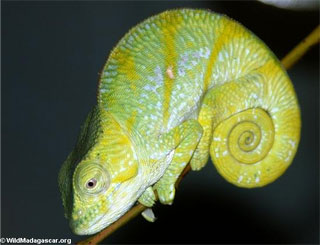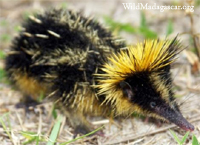Lemur land, Madagascar now protected
Rhett A. Butler, wildmadagascar.org
January 8, 2006
Madagascar is one of the world’s most special places. An island slightly larger than the state of California, Madagascar is home to a bewildering array of wildlife from dancing lemurs to absurdly colorful chameleons. Eighty percent of the island’s species are endemic, meaning they are found nowhere else on Earth.
On Madagascar you can find such evolutionary oddities as the fossa, a carnivorous mammal that looks like a cross between a puma and a dog but is closely related to the mongoose; the indri, a cat-sized lemur that leaps from tree to tree with ease and sings eery, whale-like songs; the sifaka, a lemur, that swears rudely but dances like a ballet performer; and the streaked tenrec, a spiny yellow and black insectivore that resembles a miniature hedgehog and makes grinding-chirping noises when threatened. The island has baobab trees, which look like they’ve been planted upside down; the rosy periwinkle, a delicate flower used to cure pediatric leukemia and Hodgkin’s disease; and an entire desert ecosystem consisting of just spiny plants.
While Madagascar’s fauna is brilliant and spectacular, it is also highly endangered. Significant forest loss has put many of the island unique species and ecosystems on the brink of extinction.
Madagascar’s disappearing wild lands result not from loggers, large-scale soybean farmers, or other forms of commercial exploitation, but from the actions rural families whose very survival is dependent upon subsistence use of the natural resources that surround them. Most Malagasy never have an option to become a doctor, computer programmer, factory worker, or secretary; they must live off the land and make use of whatever they can. Their day-to-day needs cost the country and the world through the loss of the island’s remarkable biodiversity.

Chameleon in Madagascar |
Over the past several hundred years Madagascar has lost its largest animals to extinction due to hunting and habitat conversion. The list includes gorilla-sized lemurs, gigantic tortoises, pygmy hippos, and the enormous Elephant bird (Aepyornis maximus) that stood ten feet (3m) tall, weighed over 1100 pounds (500 kg), and laid an egg large enough to make an omelette to feed 150 people. All these species went extinct after humans reached the island.
While is too late for some of Madagascar’s most magnificent species, the country had recently achieved a conservation milestone — one that may help prevent further disappearances, while possibly improving the livelihoods of some of the country’s poorest people.
With the official establishment of the Makira Protected Area last week, the government of Madagascar has brought the total area of land and marine zones under protection to one million hectares (3,800 square miles). The protected areas include some of the island’s most important ecosystems and will play an important role in the country’s nascent ecotourism industry. Through its network of parks and reserves, Madagascar hopes to significantly increase the number of travelers who come to observe lemurs, chameleons, and other native wildlife in their natural habitat.

Streaked tenrec |
Makira, one of Madagascar’s newest protected areas, holds a great deal of promise for eco-minded travelers. Bordering the existing Masoala National Park, Makira and Masoala form the largest contiguous tract of rainforest under protection on the island. Biologists say that one percent of the planet’s biodiversity is found in the forests of Makira and Masoala, while the nearby Bay of Antongil teems with marine life including one of the largest seasonal concentrations of humpback whales in the world.
The establishment of Makira is part of a broader conservation and sustainable development initiative first unveiled by President Marc Ravalomanana at the World Parks Congress in Durban, South Africa in 2003. In a speech that surprised most observers, Ravalomanana pledged to triple the size of Madagascar’s nature reserves by 2008 to cover 10 percent of the country’s total land area. Shrewdly telling delegates that “We can no longer afford to sit back and watch our forests go up in flames… This is not just Madagascar’s biodiversity, it is the world’s biodiversity,” Ravalomanana convinced donors that saving Madagascar’s wild places was going to require support from the international community — support which he has since found.
In adopting a pro-conservation stance, Ravalomanana saw well beyond the protection of a few flagship species, envisioning an environment where the Madagascar economy would benefit from sustainable development. Dr. Helen Crowley, Director of the Wildlife Conservation Society’s (WCS) Madagascar Program — an organization instrumental to the establishment of Makira and other protected areas in the country — explains:
-
“Protecting the forests is critical to not only wildlife, but also the people who rely on the forests for their livelihoods and resources. The majority of Madagascar’s forests have been cleared, with only 15 percent of the land surface remaining forested. Saving what’s left has become critical for all of the island’s inhabitants, humans and animals alike.”
Sustainable development and responsibly managed ecotourism can generate revenue and employ large numbers of local people without causing significant environmental damage. In Madagascar, local communities benefit directly from ecotourism through their 50% share of park entrance fees (park entry fees are divided equally between the parks service and local communities), sales of handicrafts and “tourist items,” and employment as porters, wildlife guides, park rangers, workers in the service force of hotels, restaurants and lodges. Ecotourism has great potential to diversify Madagascar’s economy beyond its current limited number of agricultural and mineral exports, while protecting its amazing natural assets.
Madagascar has also lately gotten a boost in visibility from Madagascar, an animated Hollywood film released in the spring of 2004. While the film failed to accurately portray the native wildlife or environments of the island, it generated $193 million in ticket sales and stimulated named recognition of the country. Thanks to the movie, many school children in the United States are learning more about the Indian Ocean island and its creatures. Mainstream recognition of Madagascar’s biodiversity should conservation even a larger priority in the future and may prove to be a good way to jumpstart the country’s fortunes.
Related articles:
Group completes first megatransect of Madagascar.
Late last year an international team completed the first known transect of the island of Madagascar, the world’s fourth largest island. The eight-month-long journey, dubbed “Hike Madagascar,” took the group of intrepid hikers from the southern tip of Madagascar to the northernmost point of the island. The transect targeted rural communities along the eastern forest corridor, surveying villages and providing local farmers with techniques for improving rice yields and putting more food on the table for their families. The hike also provided a glimpse into some of the socioeconomic and environmental issues facing the island nation, which is one of the poorest in the world.
Tourism in Madagascar; Visiting the World’s Most Unusual Island.
In the dry deciduous forests of south western Madagascar there lives a lemur that loudly cusses but “dances” like a ballet performer. Verreaux’s sifaka is among the most popular of lemur species, a group of primates endemic to islands off the southeastern coast of Africa. While threatened, Verreaux’s sifaka is easily spotted in several of Madagascar’s more accessible parks.
Dancing lemur attracts tourists to island of Madagascar (video).
Late last year an international team completed the first known transect of the island of Madagascar, the world’s fourth largest island. The eight-month-long journey, dubbed “Hike Madagascar,” took the group of intrepid hikers from the southern tip of Madagascar to the northernmost point of the island. The transect targeted rural communities along the eastern forest corridor, surveying villages and providing local farmers with techniques for improving rice yields and putting more food on the table for their families. The hike also provided a glimpse into some of the socioeconomic and environmental issues facing the island nation, which is one of the poorest in the world.
In Search of the Aye-aye. Seeking the world’s strangest primate on a tropical island paradise off Madagascar.
Madagascar has been called the “land that time forgot” for its collection of unique and often downright bizarre plants and animals. Around 75% of the species on the island are found nowhere else on Earth, putting Madagascar atop the list among the world’s most biologically diverse countries. Madagascar is famous for its lemurs, a group of primates endemic to the island. Among these lemurs is one of the planet’s strangest beasts, the aye-aye. This nocturnal and reclusive lemur looks like it has been assembled from a variety of animals. The aye-aye resembles a large house cat but with the face of a ferret or weasel, bat-like ears capable of rotating independently, teeth that grow constantly like those of a rodent, piercing green eyes, and black hands featuring a bony middle finger reminiscent of a dead twig. The aye-aye uses this finger for locating insect larvae that lurk deep inside tree bark, seeds, and fruit. As it climbs along a tree branch, the aye-aye taps the bark while listening for cavities in the wood. When it hears something potentially appetizing beneath the surface, the aye-aye gnaws away at the wood in search of its prize. Studies suggest that the aye-aye is capable of sensing insect movement at a depth of 12 feet.







